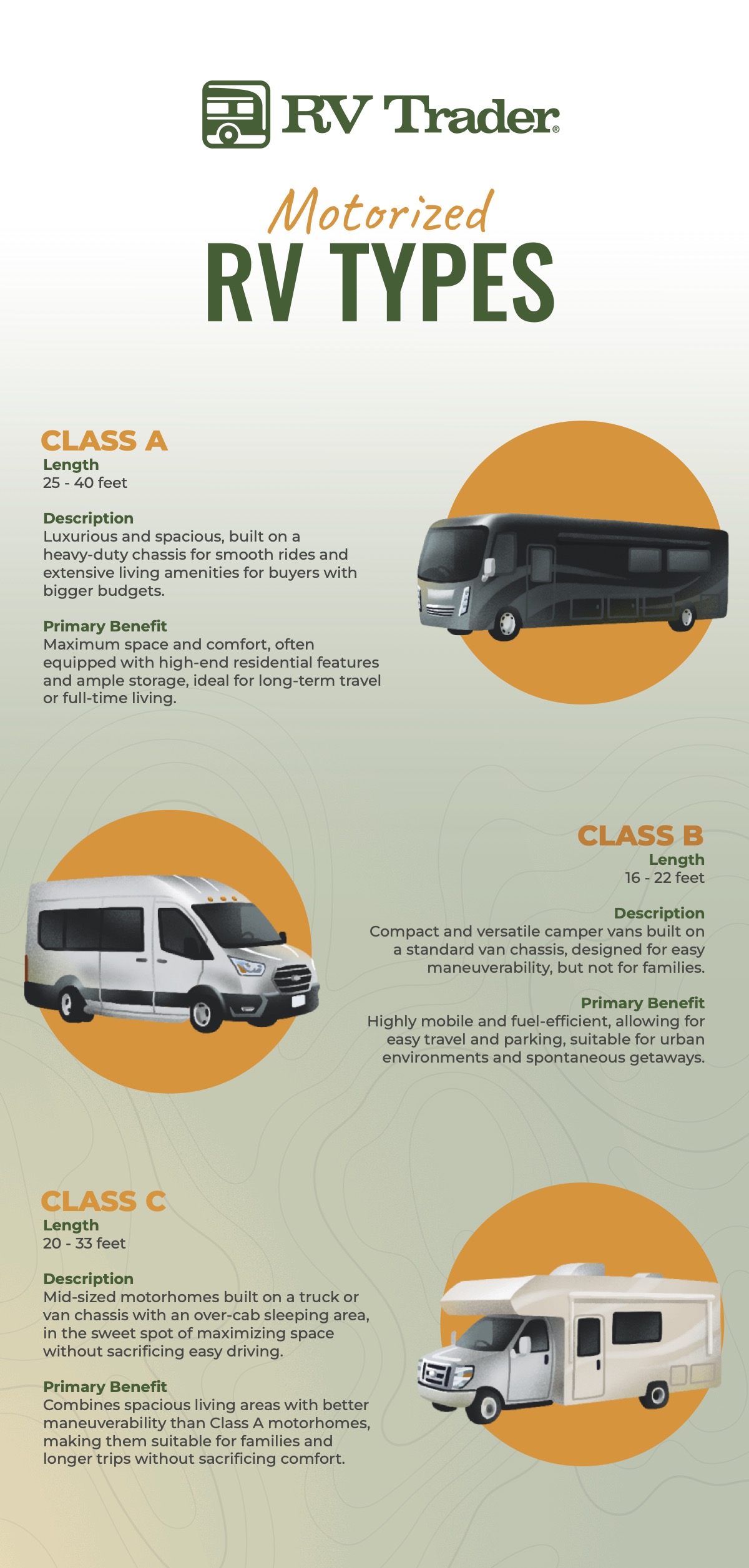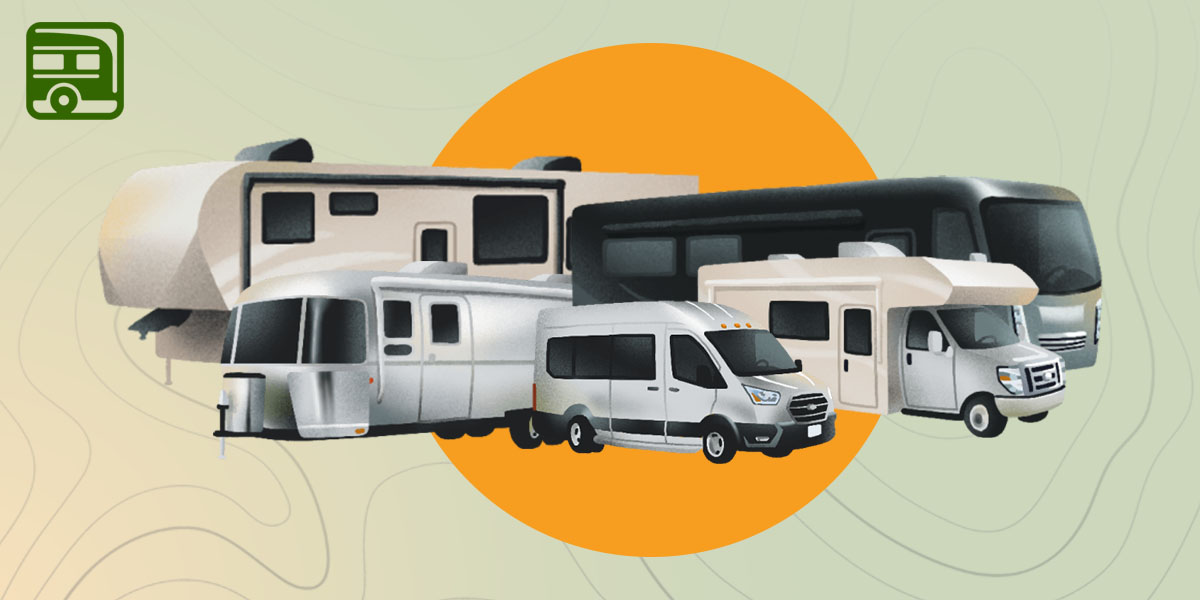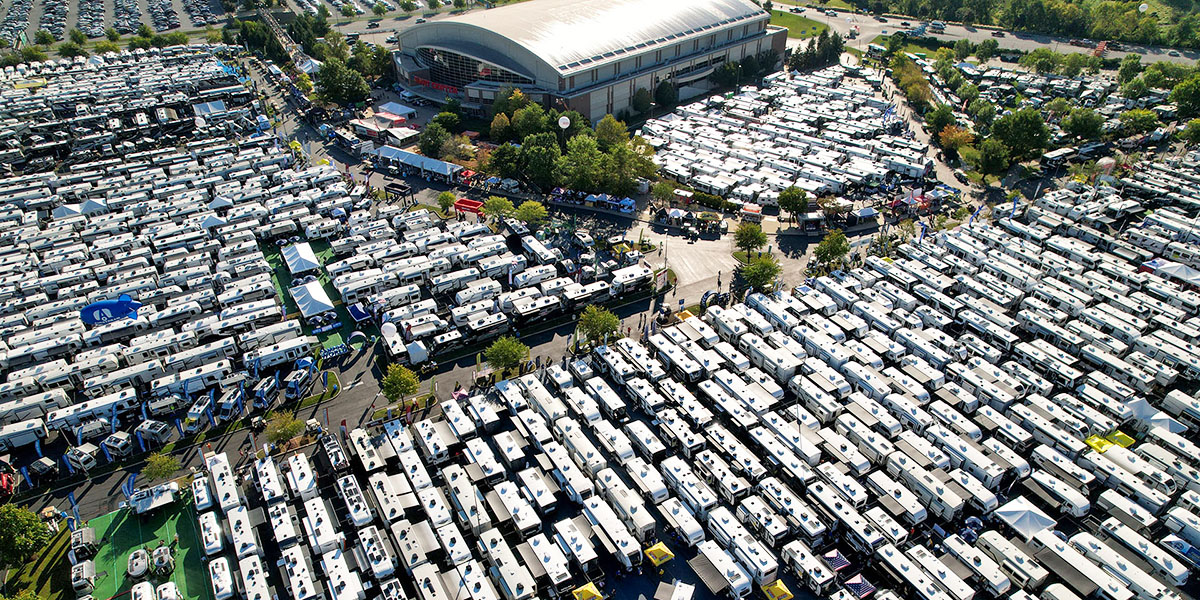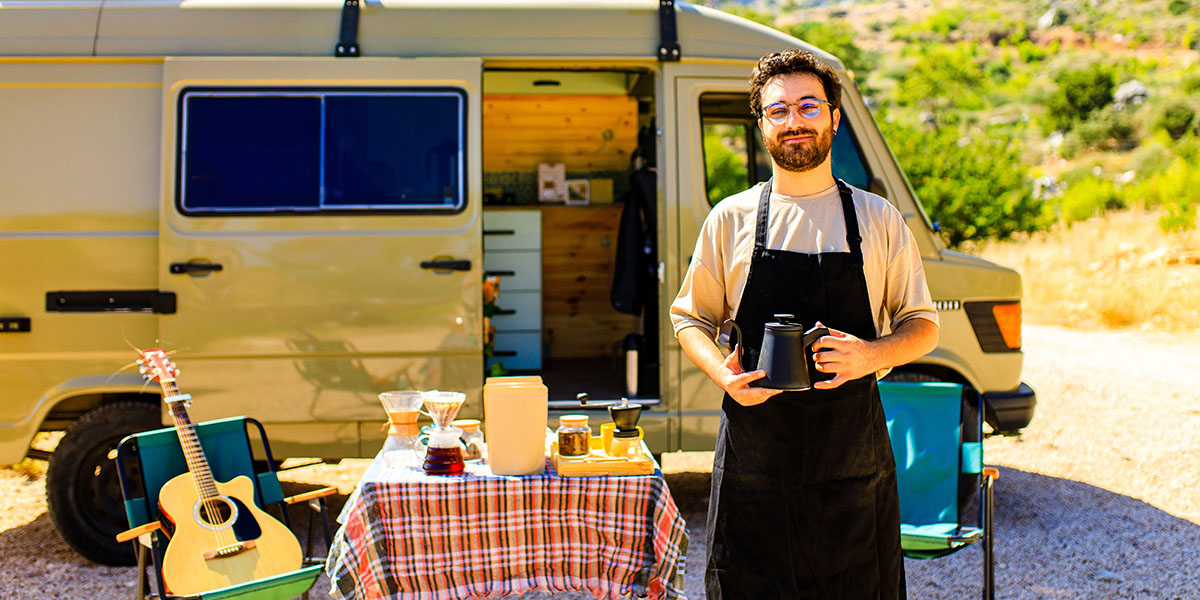The RV life offers unlimited options for adventure. You can park your rig anywhere with a reasonably flat surface. You can glamp or tent camp. Or you can pick a fancy RV park or a middle-of-nowhere state park. The options are endless. In fact, for some, the number of options can be overwhelming — especially if you are just familiarizing yourself with the different types of RV.
But we can help. If you’re looking to jump into the RV lifestyle, here’s everything you need to know to ensure you’re jumping into the right rig.
First Things First: Determine Who You Are
Step 1: Decide if you’re an overlander/boondocker or a driver/parker.
There are some among us who thrive outside the grid. They’d rather pack extra fuel for the generator than park next to the pool. They’d rather skip the hookups and sacrifice a shower here and there than stay within hearing distance of a rowdy neighbor. These hardcore adventurers are the overlanders and boondockers — travelers at the fringe of civilization. If that’s you, you’ve probably saved yourself a lot of RV shopping. Because while you can technically drive any RV into the boonies, larger models aren’t built to get you there. If you’re an overlander or boondocker type, you can reliably stick to units built for your specific needs, skipping anything that’s not. (And thereby weeding out 80 to 85 percent of the models.)
Step 2: Decide if you’re a pusher (motorized) or a hauler (towables).
You Might Be a Pusher If …
If you’ve determined you’re an on-grid RVer, the two largest categories of RVs are motorized and towables. The difference is self-explantory, but the pros and cons are many. That starts with price. Motorized vehicles are simply more expensive. In addition to buying the home, you’re buying all the equipment (engine, transmission, etc.) to make it mobile.
For some, the decision between motorized and towable is made easy by one fact: whether you have a vehicle with true towing capacity. If you don’t already have a decent sized truck or vehicle with towing capacity, you’re going to have to buy one if you want to tow a trailer.
But even if you do own a truck, there are plenty of reasons to prefer buying a motorized model. Many buyers find them more convenient to drive. Unless you’re talking about the big Class A coaches, motorized RVs are generally more maneuverable. They’re a single vehicle — versus the truck plus trailer equation. They’re also more comfortable during travel, since, unlike towables, you can lounge on long drives.
And You Might Be a Hauler If …
But if you think we’re picking on towables, think again. They have plenty of pros, including this huge benefit: When you arrive at your destination, you can detach and drive your towing vehicle. For those who want to stay in one place for longer periods of time, this ability to zip around to different parts of the area you’re parked in can often be a game changer. And if you want to bring any toys along — like an ATV or motorcycle — you’ll love the garage space some models offer. Knowing the different types of RV that offer this (toy haulers) helps narrow your search.
Additionally, towables have fewer moving parts to break down. And depending on the model, they might also might hold their value more reliably. Like cars, motorized vehicles depreciate as the miles tick away on the odometer.
Getting to Know the Different Types of Motorhomes
There’s something pure about a motorized RV. It’s a singular vehicle designed for one purpose: Delivering maximum adventure. It’s a purist’s way to mobilly roam. With towable RVs, you’re often buying more of a crash pad than a home. Your vehicle may serve to cart you to and fro — and wherever else you want to go. But with a motorhome, wherever you go, there you are. That is, until you’re ready to be gone. For motorhomes, there are three different types of RV: Class As, Bs, and Cs. Here’s what you need to know on each.

Class As
Overview: The swankiest of mobile homes, Class As are often called motor coaches. They’re the largest in terms of living space. In terms of storage. In terms of kitchens and bathrooms. On and on. They are also often finished with nicer touches. They can be built on a bus or truck chassis, delivering some of the smoothest rides around. Utilities like water tanks and electrical systems are likely to be top-of-the-line and large enough to handle longer stays. Just be prepared for all that extra Class A value to cost you a little extra.
Class As are right for: Those who want more comforts of home. (And are willing to cut a bigger check to get them.) Also, for those who are going to be living in an RV for extended periods of time.
Learn even more about Class A motorhomes.
Class Bs
Overview: Also called camper vans, there’s a cool factor to Class Bs. They’re at the small end of the size spectrum. This makes them the easiest to drive, and much more maneuverable and fuel efficient than Class As — or trailers. They deliver a smooth ride, easy setup, and more staying power (storage, living space, etc.) than smaller towables. One drawback to Class Bs is the general lack of bathroom space, though there are some convenient solutions to that issue.
Class Bs are right for: Affordable, easy weekend outings for two to three people who don’t mind sacrificing bathroom space for easy driving and parking.
Learn even more about Class B motorhomes.
Class Cs
Overview: While Class As are more like a bus, Class Cs drive and look more like a very large truck. They’re bigger than a Class B camper van, offering enough space for three to four people to stay for a week or longer. You’ll likely have a full bathroom and kitchen at your disposal, and will have enough storage to bring a few larger items to make a week long stay more comfortable.
Class Cs are right for: Longer road trips, especially for small families or those who want to balance amenities with affordability.
Learn even more about Class C motorhomes.
Getting to Know the Different Types of Towables
Towable RVs, also known as trailers, offer a diverse range of options. As you’d expect, each is configured as one of the different types of RV for those seeking the freedom of the open road without the need for a dedicated motorhome. A trailer’s single defining characteristic is being towed by a vehicle. This coupling of trailer plus car allows travelers to unhitch once they reach their destination in order to use the vehicle while the RV stays put. From compact pop-up trailers to luxurious fifth wheels, towables cater to every individual set of needs, budgets, and travel styles. Whether you’re a solo adventurer, a family on vacation, or an outdoor enthusiast with recreational gear, there’s a towable. Among trailers, different types of RV suit different preferences, providing flexibility, convenience, and the comforts of home on your travels.

Fifth Wheels
The largest of the towables, fifth wheels get their name from the special hitch that must be installed in a large pickup truck. This configuration makes them more nimble in turns and parking, but don’t let that fool you — you’ll still need plenty of practice to get comfortable with the larger trailers. Fifth wheels are generally the largest and most well-aportioned of the towables, with full kitchens and sometimes multiple baths.
Fifth wheels are right for: Buyers who already own a large pickup truck and are looking for longer stays with bigger groups.
Learn even more about fifth wheels.
Toy Haulers
Overview: The toy hauler is defined by its garage. Typically a fifth wheel, toy haulers are defined by a dedicated space for the “toys,” typically outdoor vehicles, motorcycles, or other large items. This garage area often converts into living space, though not always.
Toy haulers are right for: Towable fans who want to bring a little extra mobile fun for their adventure away.
Learn even more about toy haulers.
Travel Trailers
Overview: The classic travel trailer prototype is the Airstream Classic, which epitomizes this class. They’re bumper hitch-pulled mobile homes that can range wildly in size, amenities, and comfort. Many models maximize slide-outs, cramming as much utility as possible into a smaller chassis. The larger models will have plenty of walking around room, with full kitchen and baths,
Travel trailers are right for: RVers who want a towable without the pickup truck requirement, or those who want to maximize personality in a trailer, as travel trailers can be as quirky as you want them to be.
Learn even more about travel trailers.
Pop-Up Campers
Overview: Named for their ability to collapse into smaller sizes when not being used, pop-up campers are more about giving you a space to camp. It’s more of a way to chill in the great outdoors. Typically consisting of some sort of bedroom area, sometimes no more than tent-sized, plus a kitchen and bath (if you’re lucky), pop-ups are easy to drive, lightweight, and made for quick setup and teardown.
Pop-up campers are right for: Easy weekends away for one or two people who don’t want their RV to take up a lot of space.
Learn even more about pop-up campers.
Teardrop Trailers
Overview: Teardrops are, let’s face it, a lot about the cuteness factor. But they’re also made for simplicity. Most are basically a mobile tent with walls. (Like a popup trailer without the pop-ups.) They’re cheap, easy to use, easy to drive, easy to setup and easy to adventure in.
Teardrop trailers are right for: People who love to sleep in tents but hate setting up tents.
Learn even more about teardrop trailers.
Truck Campers
Overview: This style of small camper is almost always installed into a pickup truck bed. Some resemble a mini-Class C, with a smaller living space installed on a flatbed truck. Very often, though not always, truck campers are made to easily detach and stand alone, allowing for the truck that’s hauling it to be used at your destination. Like other small towables, you won’t typically squeeze in a bathroom, but the largest models will give you space similar to a smaller Class B or even a mini-Class C, with extra flexibility via the detachable pickup truck.
Truck campers are right for: One or two people who mostly need a mobile place to crash for a night or two.
Learn even more about truck campers.
Other Types of Specialized RVs
Specialized RVs are the outliers of the RV world, stretching the boundaries of what counts as mobile, and highly specific lifestyles and needs in mind. From the ice angler seeking warmth on a frozen lake (and maybe a reason to convince their spouse and kids to come along) to the seasonal camper setting up a long-term retreat, there’s a specialized RV built just for the job.
Fish Houses
Overview: Fish houses (also known as ice houses) are towable RVs built for ice fishing, featuring insulated interiors, built-in fishing holes, and robust heating systems. Designed to drop directly onto the ice, they allow anglers to fish in comfort while staying warm and protected from the elements. Many models also serve as year-round travel trailers, making them a versatile choice for outdoor enthusiasts. These insulated trailers usually range in size between 16 to 24 feet.
Fish houses are right for: Ice anglers who want a comfortable, warm, and efficient way to enjoy fishing through the winter months.
Learn more about fish houses.
Destination Trailers
Overview: Destination trailers are towable RVs designed for extended stays at campgrounds, resorts, or private properties. While larger and more residential in feel than standard travel trailers, they still have holding tanks and hitch connections (unlike park models), allowing them to be relocated when necessary. These trailers often feature spacious interiors, residential-style kitchens, and large windows to maximize comfort but aren’t a great choice for boondocking or frequent travel.
These long-term stay trailers most often measure between 35 and 45 feet. They come equipped with residential features, holding tanks, and the ability to relocate without professional transport. Destination trailers offers the comfort of a vacation home with the flexibility of an RV.
Destination trailers are right for: Long-term campers who want residential comforts with the flexibility to relocate occasionally.
Learn more about destination trailers.
Park Model RVs
Overview: Park model RVs are semi-permanent residences designed for long-term placement in campgrounds or private lots. They feature high ceilings, full-sized appliances, and home-like exteriors with pitched roofs and porches. Unlike destination trailers, park models most often require full utility hookups and professional transport when moving.These stationary RV usually run between 35 and 45 feet.
Park model RVs are right for: Seasonal or full-time residents looking for a spacious, home-like RV experience with permanent hookups.
Learn more about park model RVs.
Take Deeper Dive into the Different Types of RV
Did this article just whet your interest for RVs?! (Ah! We knew it!) Well, don’t stop now. Learn more about the different types of RV by diving into these explainer articles on all the different types of RV.
Class A Motorhomes: An RV Buyer Basics Guide
Class B Motorhomes: An RV Buyer Basics Guide
Class C Motorhomes: An RV Buyer Basics Guide
Fifth Wheels: An RV Buyer Basics Guide
Toy Haulers: An RV Buyer Basics Guide
Travel Trailers: An RV Buyer Basics Guide
Pop-Up Campers: An RV Buyer Basics Guide
Teardrop Trailers: An RV Buyer Basics Guide
Truck Campers: An RV Buyer Basics Guide
Fish Houses: An RV Buyer Basics Guide
Destination Trailers: An RV Buyer Basics Guide
Park Model RVs: An RV Buyer Basics Guide











